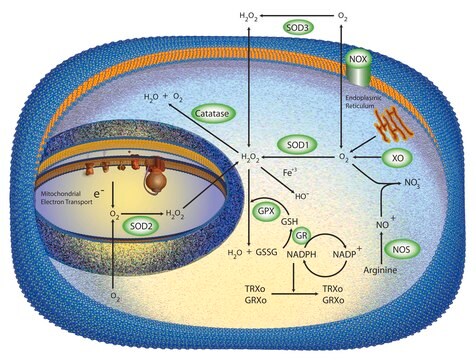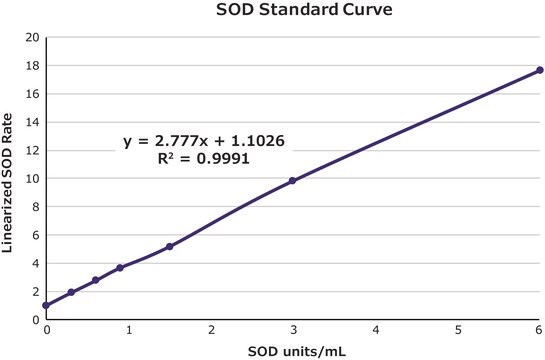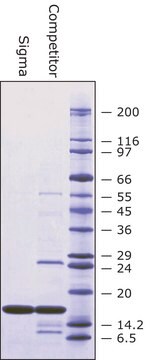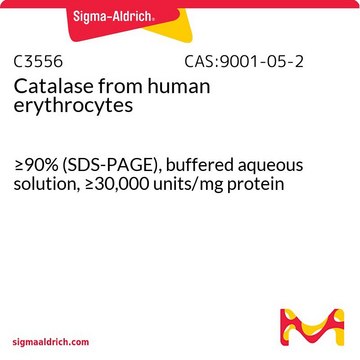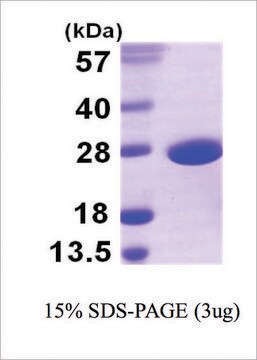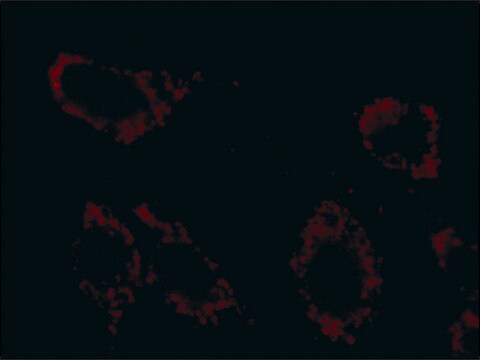Kluczowe dokumenty
S9636
Superoxide Dismutase from human erythrocytes
essentially salt-free, lyophilized powder, ≥2,500 units/mg protein
Synonim(y):
SOD, Superoxide: superoxide oxidoreductase
About This Item
Polecane produkty
pochodzenie biologiczne
human erythrocytes
Poziom jakości
Próba
>80% protein (biuret)
Formularz
essentially salt-free, lyophilized powder
aktywność właściwa
≥2,500 units/mg protein
masa cząsteczkowa
32.0 kDa
skład
Protein, ≥80% biuret
producent / nazwa handlowa
Sigma-Aldrich
metody
activity assay: suitable
kolor
white to off-white
zakres pH
7.6—10.5
pH
7.8
przydatność
suitable for molecular biology
Zastosowanie
life science and biopharma
temp. przechowywania
−20°C
informacje o genach
human ... SOD1(6647) , SOD2(6648) , SOD3(6649)
Szukasz podobnych produktów? Odwiedź Przewodnik dotyczący porównywania produktów
Opis ogólny
Zastosowanie
- to test its effect on human neutrophils in reactive oxygen species (ROS) measurement studies involving Pseudomonas aeruginosa infection
- as an antioxidant to test its effect on ROS generation induced by atmospheric-pressure plasma jet (APPJ) in red blood cell (RBC) homogenates using optical spectroscopy studies
- to test its attenuating effect on hemoglobin (Hb)-induced nuclear factor-kappa B (NF- κB) and hypoxia-inducible factor (HIF) activity in human dermal microvascular endothelial cells (HMECs-1)
- as a reference antioxidant protein to examine its expression in human intestinal Caco-2 cells following treatment with dietary flavonoids
- in combination with catalase to promote cell differentiation in vitro
Działania biochem./fizjol.
Definicja jednostki
Komentarz do analizy
Hasło ostrzegawcze
Danger
Zwroty wskazujące rodzaj zagrożenia
Zwroty wskazujące środki ostrożności
Klasyfikacja zagrożeń
Resp. Sens. 1
Kod klasy składowania
11 - Combustible Solids
Klasa zagrożenia wodnego (WGK)
WGK 1
Temperatura zapłonu (°F)
Not applicable
Temperatura zapłonu (°C)
Not applicable
Środki ochrony indywidualnej
Eyeshields, Gloves, type N95 (US)
Wybierz jedną z najnowszych wersji:
Masz już ten produkt?
Dokumenty związane z niedawno zakupionymi produktami zostały zamieszczone w Bibliotece dokumentów.
Klienci oglądali również te produkty
Produkty
Oxidative stress is mediated, in part, by reactive oxygen species produced by multiple cellular processes and controlled by cellular antioxidant mechanisms such as enzymatic scavengers or antioxidant modulators. Free radicals, such as reactive oxygen species, cause cellular damage via cellular.
Protokoły
Enzymatic Assay of Superoxide Dismutase
Nasz zespół naukowców ma doświadczenie we wszystkich obszarach badań, w tym w naukach przyrodniczych, materiałoznawstwie, syntezie chemicznej, chromatografii, analityce i wielu innych dziedzinach.
Skontaktuj się z zespołem ds. pomocy technicznej